BSCI330
University Of Maryland - College Park
Page 2 out of 20 results
Sort by
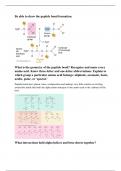
-
Proteins: Structure, Interactions, and Function
- Class notes • 2 pages • 2024
-
- $8.49
- + learn more
This study guide delves into the fundamental aspects of proteins, focusing on their structural features, amino acid composition, and interactions. It covers peptide bond formation, amino acid properties, secondary structure stabilization, and the effects of denaturing agents on protein folding. Additionally, it provides insights into predicting cleavage sites for specific proteases based on amino acid sequence analysis.
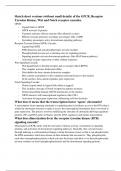
-
Cell Signaling Pathways: Overview and Mechanisms
- Class notes • 4 pages • 2024
-
- $8.49
- + learn more
This study guide provides a comprehensive overview of key cell signaling pathways, including GPCR, Receptor Tyrosine Kinase (RTK), Wnt, and Notch cascades. It covers the molecular mechanisms involved in each pathway, highlighting important signaling molecules, protein interactions, and downstream effects. Additionally, the guide explores concepts such as transcription factor activation, proteolytic cleavage, and the role of beta-catenin and the proteasome in signal transduction.
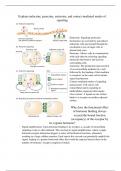
-
Signaling Modes and Molecular Mechanisms: Lecture 31 Overview
- Class notes • 8 pages • 2024
-
- $8.49
- + learn more
This study guide provides a comprehensive review of Lecture 31, focusing on various modes of cellular signaling and the molecular mechanisms underlying them. Topics covered include endocrine, paracrine, autocrine, contact-mediated signaling, and the role of G protein-coupled receptors (GPCRs) in signal transduction. Additionally, it discusses the activation and regulation of key ion channels involved in visual signaling, such as the cGMP-gated ion channel, and the adaptation of rhodopsin functio...
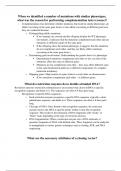
-
Molecular Genetics and Enzymology: Lecture 33 Study Guide
- Class notes • 4 pages • 2024
-
- $8.49
- + learn more
This study guide outlines key concepts discussed in Lecture 33, focusing on molecular genetics, enzyme function, and protease specificity. It covers topics such as complementation tests, restriction enzymes, cloning vectors, and the mechanisms of protease action. Additionally, it explores the specificities of trypsin, chymotrypsin, and caspase and discusses the safety mechanisms that prevent clotting factors from causing widespread protein degradation.
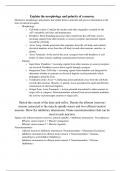
-
Understanding Neuronal Morphology, Polarity, and Electrical Signaling
- Class notes • 10 pages • 2024
-
- $8.49
- + learn more
This study guide delves into the intricate structure and functionality of neurons, highlighting their distinctive morphology and polarity, which are crucial for transmitting and processing electrical signals. The document explains key components such as the cell body, dendrites, axon, and axon terminals and elaborates on the different zones of neuronal polarity. It covers the knee-jerk reflex circuit, ion concentrations, the roles of the Na/K pump and leakage channels, the Nernst equation, actio...

-
Neural Transmission and Synaptic Function: Lecture 35 & 36 Study Guide
- Class notes • 4 pages • 2024
-
- $8.49
- + learn more
This study guide covers key concepts in neural transmission and synaptic function, focusing on the properties and types of neural fibers, mechanisms of action potential conduction, and the structure and function of synapses. It explains the correlation between nerve fiber diameter, myelination, and conduction velocity and delves into the role of capacitance in neural transmission. The guide also explores neurotransmitter types, their effects on membrane potential, and the molecular mechanisms in...
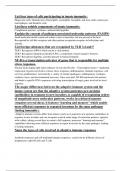
-
Key Concepts in Innate and Adaptive Immunity
- Class notes • 4 pages • 2024
-
- $8.49
- + learn more
This document provides a comprehensive overview of both innate and adaptive immune responses. It details the different cell types involved in innate immunity, the components and mechanisms of pathogen recognition, and the role of key receptors and transcription factors. The document also contrasts the innate and adaptive immune systems, explaining the structure and function of antibodies, the process of V(D)J recombination, and the factors contributing to antibody diversity. Additionally, it cov...
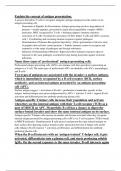
-
Understanding Antigen Presentation and T-Cell Activation
- Class notes • 4 pages • 2024
-
- $8.49
- + learn more
This document provides an in-depth exploration of antigen presentation, focusing on how antigen-presenting cells (APCs) process and present antigens to T cells. It outlines the mechanisms of T-cell activation, the role of professional APCs, and the intricacies of the immune response, including the generation of immunological memory, the differences between MHC Class I and II pathways, and the generation of T-cell receptor diversity. Additionally, it covers the timeline of immune responses and th...
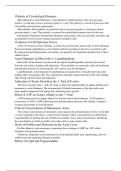
-
Cytoskeletal Dynamics and Cell Cycle Regulation: Key Concepts for Exam 3
- Class notes • 12 pages • 2024
-
- $8.49
- + learn more
This study guide provides an in-depth overview of essential topics for Exam 3, focusing on the polarity and functions of cytoskeletal elements, cell-substrate interactions, actin dynamics, and the cell cycle. Key areas include the polarity of actin filaments, microtubules, and intermediate filaments, the role of actin in cellular structures like microvilli and lamellipodia, and the impact of ATP on actin polymerization. Additionally, the guide explores the functions of various actin-associated p...

$6.50 for your textbook summary multiplied by 100 fellow students... Do the math: that's a lot of money! Don't be a thief of your own wallet and start uploading yours now. Discover all about earning on Stuvia


